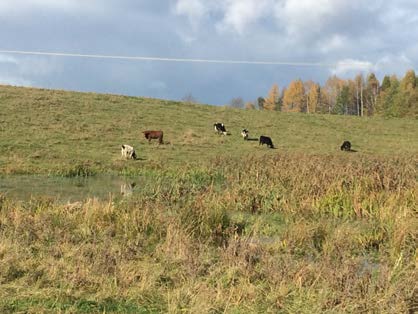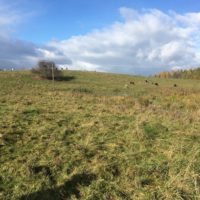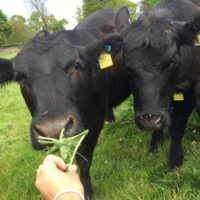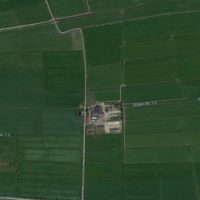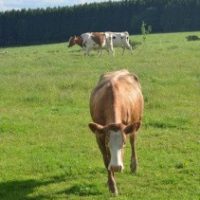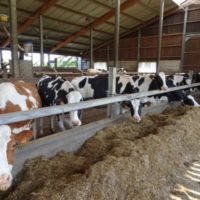Adjustment of feeding system of beef animals to different type of grasslands occurring in the farm
Farm: “Danuta Wójcicka Farm”
Location: Warmińsko-Mazurskie voivodeship, Poland
Case study
 Adjustment of feeding system of beef animals to different type of grasslands occurring in the farm (.pdf)
Adjustment of feeding system of beef animals to different type of grasslands occurring in the farm (.pdf)
Description
Background
The presented innovative farm is localized in the North-Eastern part of Poland. This region is the third one voivodship in Poland with the highest share of permanent grasslands in agriculturally utilized area (AUA) and is distinguished by the highest percentage of grasslands that are grazed. The region is well known out of its milk and beef production. Farm described in this case study is a family farm located in a small village Najdymowo near the town Biskupiec. It is run by Mrs. Danuta Wójcicka and her two sons. The farm is focused on beef production and suckler cows rearing. The farm owns 198 hectares of agricultural land. The plant production is based mainly on extensive grasslands and arable land sown with cereals and lupine, all of those are used as forage. The grasslands share in AUA in the farm is 87%. It consists of 136 hectare of different type of permanent meadows and pastures and 29.5 hectare of temporary grasslands. The area of 87 hectares of permanent meadows that are exclusively cut and the sward yield is conserved as haylage is very varied with their productivity. The average number of obtained cuts from these meadows is two per year and it is highly depends on the weather conditions. Part of the meadows is used very extensively, it means only one cut carried out in a restricted time. This is a result of restriction in management due to their inclusion into agro-environmental program. The pasture is located nearby the farm buildings and is divided into two parts by the local road. The 49 hectares of pasture are also partially included in the agro-environmental program and their use is very extensive. In those parts of grassland, the fertilization is on a very low level and applied only in the early spring. They need to be preserved in their natural botanical composition so any improvement of sward by more productive species using e.g. oversowing is not allowed. The farmer, when she describes her farm, says also a lot about high natural values of those grassland. The farm is located in a scenic hilly and forest area. On the pasture two natural ponds are located that are a natural reservoir of water. The mid-field trees give the animals some shade in sunny days. All of that gives the whole farm a lot of charm and forms an attractive landscape. The diversity of the grasslands and their different forage production potential was the main challenge for the family to create an effective system of beef production. The main goal was to obtain a livestock production that will secure the family income with simultaneous efficient use of the grassland resources and maintain the natural values of the local habitats. Important was also the partial reduction of labor time so the ambitious sons can start their studies.
Detailed description
The innovation is a rational use of fodder resources occurring in the farm by adjustment of different beef cattle feeding to different grassland types. In order to rationalize production costs and reduce labor input, the farm divided own grasslands in terms of their productivity and type of use, as well as to the nutritional requirements of the proper beef cattle feeding groups. The mowing and grazing of the permanent grasslands depends on its location and forage production potential. Also the conserved forage use for a specific group of animals depends on its quality and is based on the type of grassland it was gathered. The farm indicates various feeding groups of the beef cattle. Beef bulls for intensive fattening kept all the time in the barn receive the best forage obtained from the best quality mowed grasslands (mainly from temporary), conserved in the form of haylage. In addition, the concentrates prepared in the farm out of own cereals and lupine with a supplementation of bought protein granulate and minerals are used. Heifers for fattening in the summer are mainly grazing the pasture sward in a rotational system and receive prepared concentrates directly on the pasture. In cases of periodical low productivity of the sward, they also obtain some conserved roughage. In the winter they are kept in a cowshed and are fed with conserved feeds with addition of concentrates (similar to the bulls). The third group is the suckler cows herd. In the farm cows for reproduction and rearing are selected during period when they are young heifers. Animals for the reproduction of the herd are chosen in the way to improve its beef production value. Those ones with negative features for reproduction are designed for fattening. With the suckler cows group are also kept young ones that still stay with the cows, pregnant heifers and heifers ready for reproduction. This herd is kept all the year on the extensive pastures that are included in the agro-environmental program in the system of continuous grazing. During winter time the herd has a cowshed available and the pasture area is limited to reduce the destruction of the sod. Suckler cows in the dry period receive the worst quality feeds obtained from meadows included in the agro-environmental program. In the farm there are also kept bulls for reproduction. The insemination is mainly natural and takes place on the pasture when the bull is together with the cows chosen for reproduction. The reproduction bulls are selected from the animals that are born from artificial insemination. This way secures an inflow of new genes in the herd. Those bulls are kept and fed in the same way as heifers for fattening.
Results
Thanks to the innovation the farmer has rationalized her production costs and reduced labour input especially during vegetation period. The farmer divided own grasslands in terms of their productivity and type of use, as well as to the nutritional requirements of the proper beef cattle feeding groups. Thanks to the introduced feeding system, the farm relatively quickly receives bulls ready for sale due to an intensive feeding as well as heifers fattening on less intensive pastures. An additional benefit of introducing such solution is, noticeable by the farmer, good condition of suckler cows intended for breeding, which significantly improves the rate of calving on the farm as well as animal health and welfare. The extensive production is also compensated thanks to payments received from agro-environmental program.
Adoption criteria
The system has had worked out in this case because the farm is running in a very extensive way. All even very minor optimizations of the feeding system can give evident positive effects. The system can be directly adapted to other similar beef farms that are located in such specific habitats, where grasslands are diversified in terms of forage production potential and need to adjust of different beef cattle feeding to various grassland types. In order to transfer the innovation to a dairy farm, there should be made some changes in the animal production groups and the intensity of feeding. An important element that is supporting this system are the obtained environmental payments. They not only help but also implement a different style of the production that the presented system uses very well.
Future prospects
In the farmer’s opinion the specialized beef production carried out in the farm with the amount of owned grasslands gives a possibility to run a profitable production and gives some chances for development. She points out that the grazing during the summer time significantly reduces the costs. But there is a lot of things that need improvement to get a better economic result. To reduce costs and work time there should be made some investments in the mechanization of the cowshed like automatic manure removal system and installation of automatic drinkers. There is also still a need for improving the herd genetic to obtain better average daily gains and feed utilization. The farmer sees also possibilities to increase the grassland production by improving the botanical composition to obtain higher yields. Some adjustments can be also made in the pasture management system that will increase their utilization.
Additional information
| Farming system | conventional farming |
|---|---|
| Domains of innovation | animal feeding management, grazing management system |
| Main types of animal | beef cattle |
| Country | Poland |
| Product type | Case study |
| Language | English |

